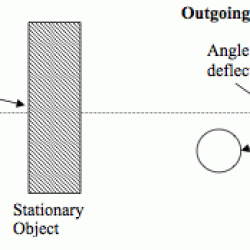Source Institutions
Source Institutions
Add to list Go to activity
Activity link broken? See if it's at the internet archive

In this activity, learners predict where a ball will go after it bounces off another object. Learners discover that the motion of objects is predictable based on laws of motion. Use this activity to explain how particle physicists use laws of motion to predict and trace the pathways of subatomic particles that are too small to see.
- 5 to 10 minutes
- 45 to 60 minutes
- 1 cent - $1 per group of students
- Ages 6 - 11
- Activity, Lesson/Lesson Plan
- English
Quick Guide
Materials List (per group of students)
- Items that you can use as stationary objects including: round cake pan, flat surface made from a thick book, large cookie cutter shapes that can include stars and others. The objects have to be substantial enough so that they are not damaged when hit by the ball. You may need something to weight down the objects as well.
- A pencil
- A ruler and/or meter stick to help roll a ball in a straight line path and to draw incoming and predict outgoing paths
- Small rubber balls (1/2 inch to 1 inch in diameter) that roll easily and will bounce off objects with little damage
- A large piece of paper (at least 12”x18”) beneath the shape makes it easier for learners to gather data as they can draw paths of incoming and outgoing balls
- Masking tape (to tape stationary objects down)
- Colored markers to trace paths of various trials
Subjects
-
Mathematics
-
Data Analysis and Probability
- Data Analysis
- Data Collection
- Probability
-
Geometry
- Plane Geometry
-
Data Analysis and Probability
-
Physical Sciences
-
Motion and Forces
- Newton's Laws
-
Structure and Properties of Matter
- Elementary Particles and Nuclear Physics
-
Motion and Forces
-
The Nature of Science
-
The Scientific Process
- Conducting Investigations
- Gathering Data
- Formulating Explanations
- Communicating Results
-
The Scientific Process
Informal Categories
- Toys
Audience
To use this activity, learners need to:
- see
- see color
- touch
Learning styles supported:
- Involves hands-on or lab activities
Other
Components that are part of this resource:
Includes alignment to state and/or national standards:
This resource is part of:
Access Rights:
- Free access
By:
Rights:
- All rights reserved, University of Kansas, 2006
Funding Sources:
- University of Kansas
- National Science Foundation, EPS-0236913
- State of Kansas through the Kansas Technology Enterprise Corporation
- National Science Foundation, EPP-0354836
- National Science Foundation, EPS-90903806
- Ewing Marion Kauffman Foundation
